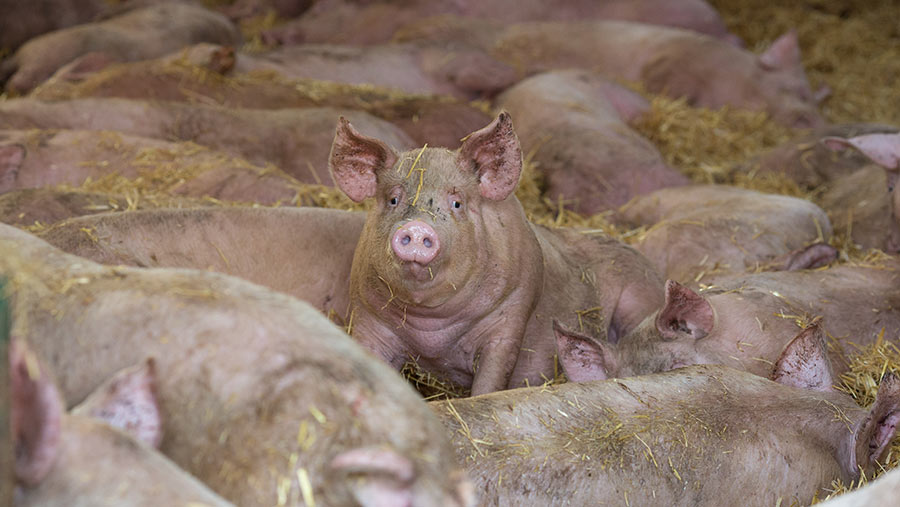How to get pig housing conditions right for best performance
 © Tim Scrivener
© Tim Scrivener A primary focus at the grower stage will be nutrition and growth to finish pigs, but it can be possible to overlook the effect of the environment on pigs’ performance.
Housing conditions can have a big impact on feed intakes, health and welfare, so attention to detail can pay dividends.
In the last of the AHDB Principles of Pig Production webinar series, vet Christina Huelsmann-Diamond of Farmvet Integrated Livestock Services highlighted a few of the considerations:
- Space requirements
- Temperature and ventilation
- Lighting.
See also: A step-by-step guide to pig heats and insemination
Space requirements for pigs
The tables below show stocking densities for standard pig systems and Freedom Foods-assured systems.
The effect of stocking density on feed intakes and growth can be seen in our guide to feed and water requirements for weaners.
Floor space requirements for non-straw housing
|
|
|
Liveweight of pig |
Floor area required/pig (sq m) |
|
Below 10kg |
0.15 |
|
10-20kg |
0.2 |
|
20-30kg |
0.3 |
|
30-50kg |
0.4 |
|
50-85kg |
0.55 |
|
85-110kg |
0.65 |
|
More than 110kg |
1 |
|
Source: Christina Huelsmann-Diamond Note: The area is often likely to be 25-30% higher than the above in straw-bedded systems |
|
Freedom Foods space requirements |
||
|
Liveweight of pig |
Floor area required/pig – mucked out (sq m) |
Floor area required/pig – deep bedded (sq m) |
|
7-35kg |
0.45 |
0.5 |
|
36-50kg |
1.17 |
1.3 |
|
51-75kg |
1.35 |
1.5 |
|
76-95kg |
1.50 |
1.67 |
|
96-110kg |
1.54 |
1.72 |
|
Source: Christina Huelsmann-Diamond |
||
Temperature and ventilation
Pigs will display through their behaviour whether they are in thermal comfort or not. Factors such as type of housing, bedding and ventilation will influence this. However, guideline temperatures to keep pigs comfortable are:
- 30kg pig – 24C
- 50kg pig – 21C
- 110kg pig – 18-20C.
Maximum air speed in the shed should be 0.15-0.2m/second. Any faster would be deemed a draught, which could be caused by air leaks, wind direction or ventilation issues.
Ventilation needs to be correct to bring in fresh air and remove warm, stale air and reduce bacterial load. It is also important to remove harmful gases such as ammonia, which could otherwise build up, as well as dusty air which can irritate the respiratory system of pigs.
Correctly directed inlets are key to air flow – the thinner the inlet, the further and faster air moves.
In a fan ventilated house, inlets can be controlled automatically to maintain a constant air inlet speed. For them to work, each room/building must be air-tight from the next. In these systems, it is law to have alarms and fail-safe devices to prevent welfare issues.
In a naturally ventilated shed, correct siting of inlets is important, as is allowing six metres between buildings to ensure good air movement. Adjustment of Yorkshire boards and galebreakers can be used to aid ventilation.
Signs of ventilation issues include:
- Pigs huddling in the warmer area of the shed
- Feed intakes dropping
- Dunging in the cold area of the pen
- Stuffy air within the building.
Lighting
The legal requirement for housed pigs is that there must be an intensity of 40 lux for eight hours a day.
It is a Defra requirement that lighting must be checked with a luxmeter and it is advisable to do this in the darkest areas of the building because this is the place an inspector will check. It must be possible to inspect lighting levels in all areas, including kennels.
Lighting will influence both feed intakes and behaviour. Pigs rest more deeply in darkness, which could help to reduce any aggression such as vice. However, if it is too dark then small pigs are less likely to get up and feed after others have finished.
One way to balance this is to provide supplementary lighting over feeders, or to position the main lights over the feeders so light disperses from that area.
Slats vs Straw considerations |
||
|
Slats |
Straw |
|
|
Pros |
|
|
|
Cons |
|
|
Online training for pig producers
This series of upskilling webinars has been run by AHDB Pork in place of face-to-face regional training during the pandemic. In 2021, AHDB Pork will be offering its popular Stockperson Development Scheme course in an online format for commercial levy payers. More information will be available in the new year at ahdb.org.uk/stockperson-development-scheme.

